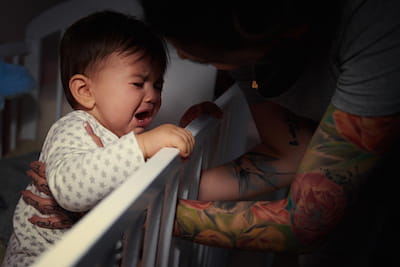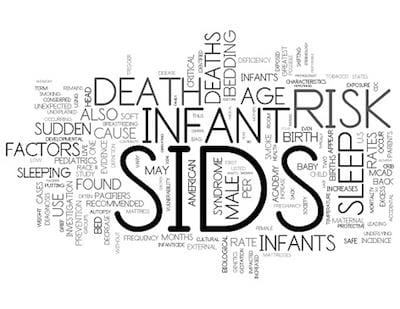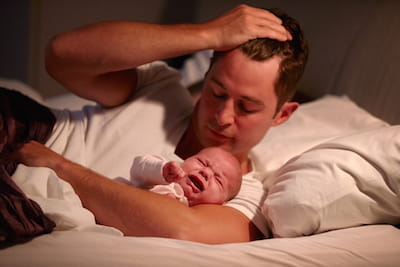Important considerations for the "same room, separate bed" infant sleep recommendations
You may have heard of a recent change to infant sleep guidelines which advocate that parents sleep in the same room but not in the same bed as their baby.
In November of 2016, the American Academy of Pediatrics updated their recommendations for a safe sleeping environment to reduce SIDS (sudden infant death syndrome). Among these recommendations is one that calls for children to sleep in their parent’s room in a separate bed for the entire first year (“ideally for the first year of life, but at least for the first 6 months”).
While I often share the AAP’s recommendations with the parents of my patients and follow their guidance myself in my own home, this is one that I believe, based on a review of the medical literature and my own professional experience caring for children day in and day out, is not advisable. There is simply not enough evidence to support this recommendation, and I fear that this recommendation will harm families and actually lead to an increase in SIDS.
Why I disagree with “same room, separate bed” advice
A practical dilemma
 My biggest concern is that this recommendation will lead to an increase in infants sleeping in bed with their parents thus actually increase the risk of SIDS. Research has clearly shown that bed-sharing (child sleeping in bed with parents) greatly increases the risk of SIDS. In over 20 years of pediatric care, I have never met a family where children slept in the parents’ room in a separate bed for an entire year. Children (after the first few months) either sleep in their own bed in their own room or sleep in bed with their parents. While the benefits of bed-sharing are often argued by bed-sharing advocates, even bed-sharing advocates acknowledge that sleeping in the parents’ bed increases the risk of SIDS. When children who are in the same bedroom wake in the night, tired parents tend to calm them by bringing them into their bed. When children wake at night in their own room most parents attempt to calm them and return to the child’s own bed.
My biggest concern is that this recommendation will lead to an increase in infants sleeping in bed with their parents thus actually increase the risk of SIDS. Research has clearly shown that bed-sharing (child sleeping in bed with parents) greatly increases the risk of SIDS. In over 20 years of pediatric care, I have never met a family where children slept in the parents’ room in a separate bed for an entire year. Children (after the first few months) either sleep in their own bed in their own room or sleep in bed with their parents. While the benefits of bed-sharing are often argued by bed-sharing advocates, even bed-sharing advocates acknowledge that sleeping in the parents’ bed increases the risk of SIDS. When children who are in the same bedroom wake in the night, tired parents tend to calm them by bringing them into their bed. When children wake at night in their own room most parents attempt to calm them and return to the child’s own bed.
Insufficient evidence
The November AAP safe sleeping policy statement lists four research articles that support the “same room, separate bed” recommendation. None of these articles seem relevant today. The data from these articles was collected between 1987 and 2000 in Europe and New Zealand. Why was this recommendation made 15 to 30 years after the data was collected? During this time there was a much higher incidence in prone sleeping, smoking and SIDS. Prone sleeping and smoking are major established risk factors for SIDS. In the largest of these studies 61% of mother smoked and in another 61% had a parent that smoked! The Centers for Disease Control and Prevention (CDC) reports that only 16% (yeah, reverse the digits) of adults in the United States smoked in 2013. This “same room separate bed” recommendation may apply to heavy smoking, prone sleeping populations but does it apply today? We are going to need new research with study subjects similar to the current population to say that for sure.
I’m no statistician, but a little research led me to question these articles even further. All these studies are retrospective “case control” studies. Researchers would learn about a child who died of SIDS and then compare it to similar children chosen by the researcher who didn’t die from SIDS.
 The incidence of SIDS in the United States is similar to the of odds of flipping heads on a quarter 10 times in a row. To give you an idea of how case-controlled studies work, let’s discuss a pretend case-controlled study of 6th-grade boys who flipped heads 10 times in a row on a quarter. Researchers would interview the parents of the 324 6th grade boys who flipped heads on a quarter 10 times in a row and then interview the parents of 324 6th grade boys who were unable to flip heads on a quarter 10 times in a row. They would ask questions about where it was done, which hand was used, time of day and the starting position of the coin. If twice as many head flippers were left-handed, researchers could conclude that left-handedness increases the chance of flipping heads. As you can imagine some of the information yielded from these case controlled studies is helpful, but much of it is based on chance.
The incidence of SIDS in the United States is similar to the of odds of flipping heads on a quarter 10 times in a row. To give you an idea of how case-controlled studies work, let’s discuss a pretend case-controlled study of 6th-grade boys who flipped heads 10 times in a row on a quarter. Researchers would interview the parents of the 324 6th grade boys who flipped heads on a quarter 10 times in a row and then interview the parents of 324 6th grade boys who were unable to flip heads on a quarter 10 times in a row. They would ask questions about where it was done, which hand was used, time of day and the starting position of the coin. If twice as many head flippers were left-handed, researchers could conclude that left-handedness increases the chance of flipping heads. As you can imagine some of the information yielded from these case controlled studies is helpful, but much of it is based on chance.
Case-controlled studies are inherently flawed. Investigators can manipulate the data to support their own beliefs. One statistician from the University of Alabama Birmingham (where I trained) said that he would not “be impressed” by less than a four-fold change in case control studies. Only one of the four articles touted more than a four times risk of sleeping in the own room. Three of the articles found an unimpressive 2 to 3-fold increase in SIDS and one found a 10-fold risk. Importantly, this study (Blair et. al.) only found a two-fold risk when they analyzed sleeping in their own room alone, but only when they evaluated multiple variables did their significance grow to 10-fold. The fact that the results of one small study (only 325 cases) differs from the other three and that it needed statistical manipulation to obtain the “impressive” result only creates further doubts. The Blair et al study even states, “… further research is required to investigate whether room sharing is protective in itself or merely a marker for hidden confounders not measured in this study.”
Unanswered questions

Importantly, none these studies looked at when it is best to move a child into their own room. It has never been shown that 12 months is safer than 13 months. None of these studies even looked at 13-month-olds. The recommendation of sleeping in the parents’ room for 12 months is only based on the definition of SIDS. SIDS is unexplained death in the first 12 months of life. None of these studies looked at the impact of room sharing on the family. In my experience, children and parents sleep better when children move to their own room. How does room-sharing effect parental sleep? How does it affect marriages? How does this increase stress effect the family? All of these are important considerations.
The “same room, separate bed” recommendation is simply not supported by facts or parenting experts. I’ve talked to many experienced parents and seasoned pediatricians about this recommendation. None of them agree with this recommendation. Many of them share my concern that the parents will end up pulling their children into their beds and ultimately increase the incidence of SIDS.







